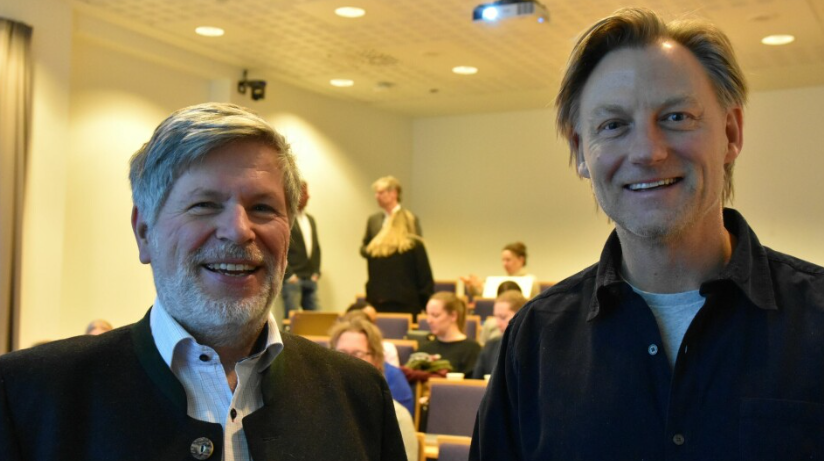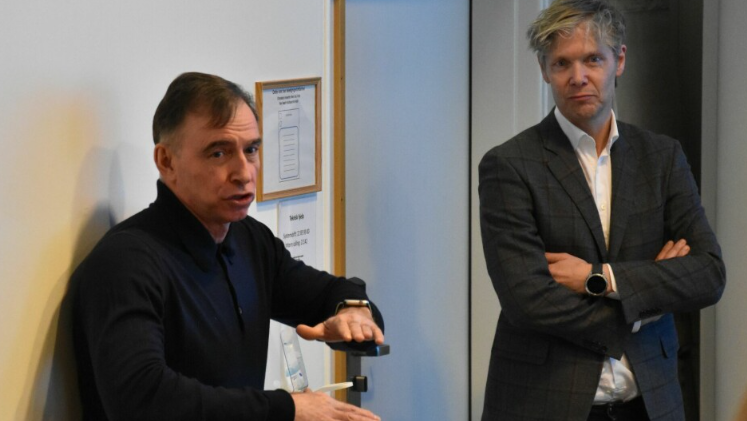Authored By:

Germany, like Norway, faces challenges in terms of personnel shortages, a baby boom generation heading into retirement at full speed and rising costs in the healthcare system. German health leaders visited Norway to learn.
There is always something to learn when you visit other hospitals and health institutions. We in Germany face the same challenges within the healthcare system as Norway does in terms of personnel shortages, an increasing proportion of the population getting older and higher costs. I think it is completely the same in both Norway and Germany, says Lorenz Trümper, managing director of the University Hospital in Göttingen to Dagens Medisin during his visit to Rikshospitalet and Oslo University Hospital.

Lorenz Trümper and parts of the management at the University Hospital in Göttingen and the University Clinic in Bonn in Germany visited Norway and Oslo University Hospital.
The German hospital director says the challenges are about being able to recruit, retain and have properly qualified personnel. The German health leaders were visiting Norway to learn about different strategies to meet these challenges, and in particular to learn about the Norwegian Competence Portal, which the Norwegian company Dossier Solutions supplies.
Mapping competencies
Dossier helps hospitals to have an overview of what the staff can and are trained in, so that the hospital knows that they meet quality requirements and maintain patient safety. The Competence Portal software gathers the employees’ expertise and contributes to a “competency overview” for both the individual employee, managers and healthcare organizations.
The health sector is dependent on large numbers of new employees and students to maintain the treatment offer. Dossier helps with structured training to get new employees into the job as quickly as possible. Much of this training work is paper-based today, we give the health sector the tools to do this digitally, says Geir Arnhoff, managing director of Dossier Solutions.
All health organizations in Norway and a large part of the municipal health service use Dossier today. In addition, the company supplies the solution to more than 300 hospitals in the US, a market they entered in 2019.
Norway is ahead of the game
Arnhoff explains that, as has traditionally been the case through training, having checklists of courses and procedures and entering them manually in Excel and other makeshift solutions is both time-consuming and often difficult to find again once the file has been archived.
It takes a lot of time and it is difficult to know for sure whether employees have received training in the correct procedures and material. The hospitals end up with good quality in the end, but they spend a lot of time on it. This solution saves time and helps to make quality measurements easier.
In Germany, there will be a new law in March that requires quality data to be published and made public.
Norway is well advanced when it comes to digitization and standardization in the healthcare system. Germany faces many of the same challenges we have found solutions for in Norway and is now coming to Norway to learn from our experiences.
Hospital director Trümper believes such a system is of great value.
That is why we come here to learn from those who have already put this to use. Now we want to see if this is possible to achieve with us.
The innovation project that is ongoing between Dossier and the two German hospitals has a total budget of over five million kroner. Now the company is working with Innovation Norway to find good ways to scale in the German market, and to achieve the same standardization as has been achieved in Norway in Germany.
Relevant with a view to retaining employees
At Rikshospitalet, the German delegation was given a review and demonstration of how the Competence Portal works at Oslo University Hospital by advisers Nikolai Mørck and Malin Vik Malnes. Oslo University Hospital was among the first to try out the Competence Portal.
They are two of five who have worked in the project team for the introduction of the Competence Portal. The project has now ended and operations are now over at the Department for competence development in the clinic.
Dossier manager Arnhoff says he is very impressed by the introduction of Oslo University Hospital. He highlights in particular how the two advisers have made themselves available for questions as an important success criterion.
The team that has worked with the Competence Portal here has made an enormOslo University Hospital effort, and has been responsible for what is probably the most effective and focused implementation of our system in a hospital. That is impressive! The implementation has been well organized, says Arnhoff.
Head of department Knut Arne Pedersen, HR staff, Oslo University Hospital was also present at the session and the presentation for the German health managers. Pedersen was also part of the project team for the introduction. Pedersen stated at the session that the tool is also relevant in terms of preventing healthcare personnel from leaving their jobs.

When someone quits their job at Oslo University Hospital, they answer a survey about why. Many respond that there is too little room for further education and competence building in their role. In this way, this becomes a relevant tool for not only mapping competence, but also for planning good and relevant competence development for each individual employee, Pedersen stated at the session.
We don’t have “state of the art” tools, we were able to demonstrate that here today
Helle Dokken is Norwegian and director of nursing at the University Hospital in Göttingen. She says their goal is to map out which skills, in addition to nursing education, their employees need to do the best possible job with the patients.
We are not good enough there today. We have a cumbersome system and use a lot of excel tables and other not “state of the art” tools. We have gained an insight into the “state of the art” here. We would like to put such a system in place to be able to move forward in this area, says Dokken.

She says that in order to manage to systematize the information, to know who knows what and who needs more training or education, there is a need for such a tool as Oslo University Hospital and other health organizations in Norway use today.
Dokken gives an example that if a nurse with them wants to change departments and work elsewhere, then the system that Dossier offers will make it possible to “take” the expertise to the new department.
You don’t do that today. Then you have to start a new competence mapping. This is also very useful in terms of students for the university hospitals, where you can document and take your skills with you.
Dokken sees the system as a good tool for managers in terms of knowing what skills they need and what they have.
And what do we have expertise in that we don’t need? It is very clarifying for all managers, but also for the nurses, who then get to know what it is they need from courses and knowledge. And the fact that you can take this with you to new workplaces saves time.
She believes that such a portal and overview will help both managers and employees save time on these things.
And not least, it’s nice to know and get an overview that you’ve done what you’re supposed to, both for the individual employees and managers.
Welcomes the restructuring of the German health service
In Germany, there is now a debate about restructuring the health service due to the challenges of personnel shortages, more elderly people and financial challenges.
The government wants more transparency about quality and new “levels” of hospitals. A total supplier of health services and regional health centers that will provide for the population’s basic health service needs.
In Göttingen, such a health center will now be established, one of the first of its kind. Hospital director Trümper believes it is a good change.
This is a major upheaval of the health service. I think it’s a good change in terms of the future, but there are big political discussions and a lot of opposition. One of the consequences of this change is that one in three hospitals will disappear. There is no economy to run everyone like today.
He refers to how the health crowns are used now compared to before, which he believes plays a big role.
Adopt new treatment methods. The costs of new methods have exploded and take a much larger part of the money pot. The total health budget has not shrunk, but it is spent differently on, for example, new methods.
Trümper believes that the financing of pharmaceuticals will perhaps change in Germany, and that the challenges in health are probably one of the biggest political headaches in Germany right now.
The hospital director says the closure of a third of the country’s hospitals has met with a lot of opposition from residents and politicians at local level. He is more uncertain about whether it will be carried out.
I see it as a necessity because of quality and personnel.
50/50 if it goes through
He refers to the challenges that both Germany and Norway face, fewer people of working age and a larger baby boomer generation that is at full speed into retirement.
Therefore, we need a restructuring of the service. I don’t think we will get more people to work in the health care system.
If you had asked me a year ago whether the government would succeed in this, I would have said yes. Now it’s more 50-50. There is a lot of opposition, especially from the wealthier parts of the country. But I don’t think a restructuring will go beyond patient care.




